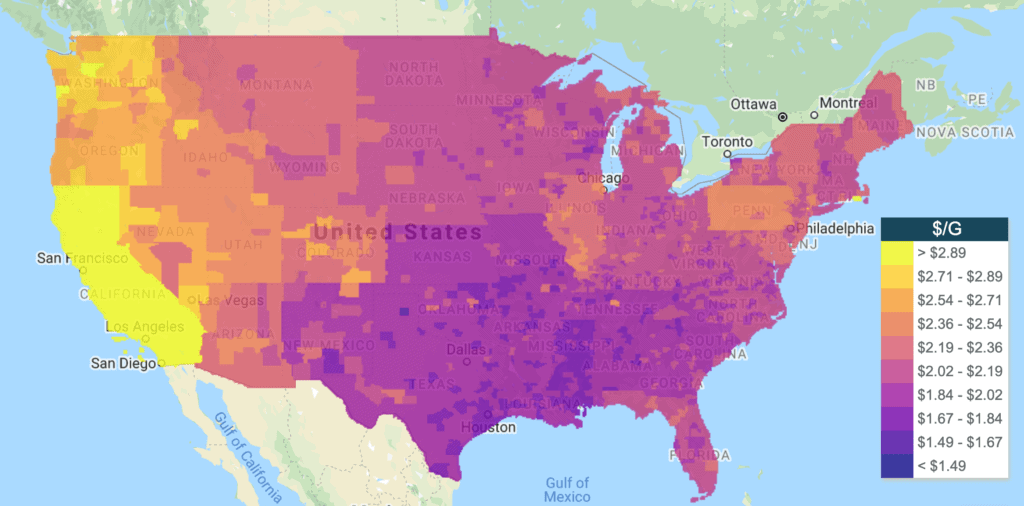One of the best benefits of van life is lowering your cost of living–no rent, no utility bills, no “hidden fees”. But that doesn’t mean van life is free, or even cheap at times. Depending on miles driven each month, you could be looking at gas costs that match an inexpensive room rental. But how can you figure out gas costs per month while maintaining your desired travel schedule before spending hundreds?
It all comes down to planning! And sometimes planning is just tough. That’s why I’ve created this “gas calculator” to help you determine monthly gas costs depending on your van type, time of season, and the region in which you’re traveling. So before you purchase the van of your dreams, try to get a feel for how many miles you’ll be driving each month. Then, use the formulas below to determine roughly how much you’d be spending on gas per month.
Obviously, the one factor we can never know for sure is the gas price, but I’ve tried to break it down into ranges depending on season and location. And if you’re really determined to save as much as possible on gas, you can plan your travels according to these locations and seasons where gas will be the cheapest. First off, a little insight into gas prices…
Why do gas prices vary so much?
Gas prices vary due to crude oil prices, supply and demand, differing state taxes, seasons, and changing gas specifications. Even when crude oil prices are stable, gas prices can still vary based on seasonal changes in supply and demand.
Particularly at this time in the nation, we’ve seen a serious plummet in gas prices due to COVID-19. People are working remotely, not commuting, and generally traveling less–meaning a serious drop in demand for gasoline. This is good news for van dwellers who can embrace the lower-than-usual gas prices.
Factors affecting gas prices by state
There are a few main factors that play into why gas is so much cheaper in, say, the southern states compared to the west coast. These factors include:
- Proximity to distribution centers: The farther gas has to travel to get from an oil refinery into your gas tank, the more expensive it will be. This price tag comes in the form of pipeline tariffs that are charged to shippers moving their oil through pipelines. Pipeline operators will determine fees based on distance traveled, similar to how toll booths operate. Part of the reason southern states have lower gas prices is because they’re much closer to an oil refinery hub on the gulf coast.
- State taxes: State taxes are probably the biggest determining factor on how high or low gases prices will be in a certain state. While the national state tax average sits at $0.48 per gallon, some states have much higher gas taxes than that. According to good ‘ol Wikipedia, “The American Petroleum Institute uses a weighted average of local taxes by population of each municipality to come up with an average tax for the entire state. Similarly, the national average is weighted by volume of fuel sold in each state.”
- Refining: Different states require different levels of refining for their gasoline. For example, California has some of the strictest environmental laws in the US and this is reflected in the level of gas refining they require. Of course, more refining equates to higher gas prices. Whereas many of the southern states have some of the lowest refining requirements, thus reducing fuel costs.
Heat map of gas prices by state from Gas Buddy:

Factors affecting gas prices by season
Ever notice how it’s more expensive to fill your tank in the summer than it is in winter? There’s actually a main reason for this. Let’s start with this reason…
- Reid Vapor Pressure (RVP): Reid Vapor Pressure is used to measure the ability of gas to evaporate. Basically, in order for a car’s engine to work properly, gas has to be able to evaporate from it. In the wintertime, the colder temperatures make it harder for gas to evaporate, so refineries actually change the gas blend to have a higher RVP. In the summertime, gas evaporates even faster, so they change the blend to have a lower RVP–and this type of blend is more expensive to make. Hence, the higher gas prices in summer. That being said, the wintertime blend is less fuel efficient, so you may not be getting as many miles to the gallon in wintertime!
- Supply and Demand: Not surprisingly, people are a lot more “out and about” and traveling during the summertime. The increase in demand for gas means higher prices, and vice versa during the wintertime.
Miles Per Gallon (MPG) of popular conversion vans
(and their city version counterparts)
I chose to base data off of the 2016 model of each van (if it was available) because it seems to be a popular year of choice for vanlifers. This makes sense to me because the vans are still relatively new but without the brand new price tags. EXCEPT the Ford Econoline, where I’ve listed the 2014 model specs – because the Econoline of the van conversion style was discontinued in 2014 (read more about Ford Econolines for van life here).
Full-Size Cargo Vans MPG Data:
| Van Type | City MPG | Highway MPG | Average MPG |
| Mercedes Sprinter | 20 | 23 | 21.5 |
| Ford Transit | 15 | 19 | 17 |
| Ford Econoline (2014) | 13 | 16 | 14.5 |
| Nissan NV | 11 | 15 | 13 |
| RAM ProMaster (2018) | 13 | 18 | 15.5 |
| Chevy Express | 11 | 17 | 14 |
Compact Cargo Vans MPG Data:
| Van Type | City MPG | Highway MPG | Average MPG |
| Mercedes Metris | 21 | 24 | 22.5 |
| RAM ProMaster City | 21 | 29 | 25 |
| Ford Transit Connect | 22 | 29 | 25.5 |
| Nissan NV200 | 24 | 26 | 25 |
How to calculate gas costs per month for your van:
If you jumped straight to this calculation section from the top of this page, be sure to reference the sections above it to find your own data on gas prices and van MPG.
Here’s the formula:
(total monthly mileage) / (average MPG of your van) = (# of gallons of gas needed)
Then…
(# of gallons of gas needed) x (price of gas) = your estimated gas costs for the month
Here’s an example:
Let’s say Sally is driving about 1,555 miles per month. She drives a Ford Econoline, so she’s getting about 14.5 miles per gallon. She’s been in the Pacific Northwest during summertime, where the average gas prices have been around $2.50 per gallon. So, let’s plug this in.
(1,555) / (14.5) = 107 gallons of gas needed for one month
Then…
(107) x (2.50) = $268 are her estimated gas costs for the month
Want more van life content and tips? Subscribe to the blog!
